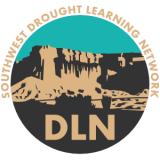Southwest Drought Briefing: September 19, 2023
The Southwest saw an underperforming monsoon this summer, and short-term drought emerged in central/eastern Arizona and in New Mexico. As the region transitions to autumn, how will these short-term drought conditions affect long-term drought? This webinar looked at current and forecasted drought conditions for Arizona, Colorado, New Mexico, Nevada, and Utah, then highlighted the National Coordinated Soil Moisture Monitoring Network.
For more information, please contact Gretel Follingstad (gretel.follingstad@noaa.gov).






